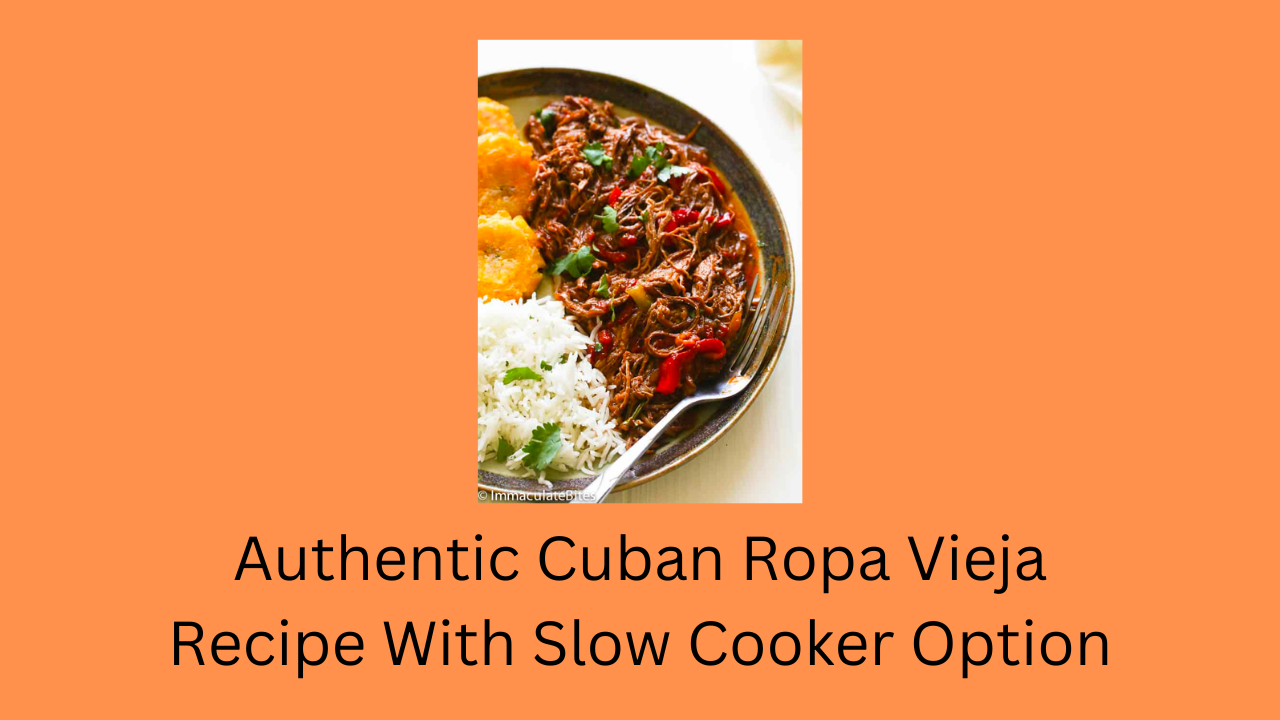Embark on a culinary journey to the vibrant streets of Cuba as we explore one of the island’s most cherished dishes – Ropa Vieja. Translated as “old clothes,” this delectable shredded beef dish is not only a testament to Cuba’s rich culinary heritage but also a celebration of flavors that have stood the test of time.
In this blog post, we invite you to uncover the secrets behind crafting an authentic Cuban Ropa Vieja, ensuring that each bite takes you straight to the heart of Havana. What sets this recipe apart is not just the delicious blend of spices and ingredients, but also the option to slow cook this iconic dish. Perfect for those who appreciate the convenience of modern cooking techniques without compromising the essence of traditional Cuban cuisine.
So, whether you’re a seasoned home chef eager to expand your repertoire or someone with a longing for the taste of Cuba, join us as we dive into the enticing world of Ropa Vieja – a dish that transcends generations and continents, bridging cultures with its savory allure. Get ready to infuse your kitchen with the soul-warming aromas of Cuban spices and the unmistakable comfort that only an authentic Ropa Vieja can deliver.
What Is The Ropa Vieja Sauce Made Of?
The soul of Ropa Vieja lies in its rich and flavorful sauce, a symphony of ingredients that meld together to create a complex and satisfying base for the shredded beef. Here’s a breakdown of the key components:
The Aromatic Foundation
- Sofrito:
This vibrant Cuban condiment forms the aromatic base of the sauce. It’s typically made with a blend of onions, bell peppers, garlic, cilantro, and spices like cumin and oregano, all finely chopped and sauteed until softened and fragrant.
- Mirepoix:
While some recipes use sofrito, others rely on a classic mirepoix of chopped onions, celery, and carrots. This French technique adds sweetness and depth to the sauce.
The Tomato Embrace
- Tomato Sauce:
A key element, tomato sauce provides acidity and body to the sauce. You can use canned crushed tomatoes, tomato puree, or even passata for a richer flavor.
- Tomato Paste:
Concentrated tomato paste adds depth of color and umami to the sauce.
The Flavor Symphony
- Spices:
A warm blend of spices like cumin, oregano, bay leaves, and paprika infuses the sauce with earthy and savory notes. Some recipes might also include smoked paprika, cloves, or allspice for added complexity.
- Acidity:
A splash of vinegar or capers adds a welcome tang to the sauce, balancing the richness and sweetness.
The Finishing Touches
- Olives, Capers, or Raisins:
These optional ingredients add pops of briny, tangy, or sweet counterpoints to the sauce. Choose one or a combination to personalize your Ropa Vieja.
Simmering to Perfection
All these elements come together in a slow simmer, allowing the flavors to meld and deepen. The low and slow cooking process extracts the essence of the vegetables, spices, and meat, creating a rich and flavorful sauce that coats the shredded beef beautifully.
Remember, there’s no single “correct” recipe for Ropa Vieja sauce. Feel free to experiment with different ingredients and proportions to find your perfect balance of flavors. The key is to use fresh, high-quality ingredients and let them simmer with love to create a sauce that will transport you to the heart of Cuba with every bite.
Is Ropa Vieja African?
Yes, Ropa Vieja has African origins. The dish is believed to have originated in Spain among the Sephardic Jews, who brought it with them to the Americas when they were expelled from Spain in 1492. The Sephardic Jews were originally from North Africa, and their cooking was influenced by the flavors and ingredients of the region.
Ropa Vieja is a type of shredded beef stew, and it is similar to many other African stews, such as jollof rice, mofongo, and porcupine stew. All of these stews are made with shredded beef, tomato sauce, and spices, and they are often served over rice.
There are many different variations of Ropa Vieja, and the exact ingredients and proportions can vary depending on the region or family. However, the basic ingredients of Ropa Vieja are always the same: shredded beef, tomato sauce, and spices.
Here are some of the African influences on Ropa Vieja:
- The use of shredded beef:
Shredded beef is a common ingredient in African cooking, and it is often used in stews and soups.
- The use of tomato sauce:
Tomatoes are a New World crop, but they were quickly adopted by African cooks. Tomato sauce is a common ingredient in many African stews, including Ropa Vieja.
- The use of spices:
Spices are a key ingredient in African cooking, and they are used to add flavor and depth to dishes. The spices used in Ropa Vieja, such as cumin, oregano, and bay leaves, are also common in African cooking.
Ropa Vieja is a delicious and versatile dish that is enjoyed by people all over the world. It is a testament to the rich culinary heritage of Africa and the Americas.
Authentic Cuban Ropa Vieja Recipe With Slow Cooker Option
This aromatic stew, featuring tender shredded beef in a tangy tomato-pepper sauce, is a testament to Cuban ingenuity, transforming leftover meats into a culinary masterpiece. Now, with the magic of the slow cooker, you can recreate this national treasure in the comfort of your kitchen, filling your home with the intoxicating aromas of Cuba.
A Journey Through Time and Spice
Ropa Vieja’s roots stretch back centuries, tracing its lineage to Spanish Sephardic stews and the resourceful frugality of Cuban kitchens. Traditionally made with flank steak or chuck roast, the meat was simmered for hours, coaxing out its essence and transforming it into melt-in-your-mouth shreds. This slow-cooking technique became even more crucial when firewood was scarce, and patient simmering transformed tough cuts into culinary magic.
The Symphony of Ingredients
Every region of Cuba boasts its take on Ropa Vieja, yet the core melody remains constant. The symphony of flavors begins with a vibrant mirepoix of onions, bell peppers, and garlic, sautéed until softened and kissed with golden caramelization. Next, a rich tomato base, often infused with sofrito (a vibrant Cuban condiment), is poured in, blanketing the vegetables in a warming embrace.
The Star of the Show
The heart of Ropa Vieja lies in the meat. Traditionally, flank steak or chuck roast, known for their intense beefy flavor, are simmered until fork-tender. The slow cooker becomes your culinary ally in this process, transforming tough fibers into melt-in-your-mouth tenderness. As the hours tick by, the meat infuses the sauce with its essence, creating a harmonious blend of textures and flavors.
The Finishing Touches
A symphony of spices like cumin, oregano, and bay leaves adds depth and warmth to the broth. A splash of vinegar or capers provides a welcome tang, while olives, capers, or raisins add pops of briny or sweet counterpoints. The final act involves shredding the tender meat, incorporating it back into the sauce, and letting the flavors meld into one cohesive melody.
Slow Cooker Magic
The slow cooker simplifies the Ropa Vieja journey, allowing you to savor the essence of Cuba without hours of hovering over the stove. Simply brown the meat and vegetables in a skillet, then transfer everything to the slow cooker with your chosen broth and spices. Let the magic of low and slow cooking work its wonders, filling your home with the heady aroma of Cuban comfort food.
Serving Up Sunshine
Ropa Vieja is traditionally served over white rice, creating a canvas for the vibrant stew to shine. Scatter freshly chopped cilantro on top for a pop of freshness, and don’t forget the tostones (fried green plantains) for a satisfying crunch. Each bite is a journey to the sun-drenched streets of Havana, a testament to Cuban resourcefulness and the transformative power of slow cooking.
Beyond the Recipe
Ropa Vieja is more than just a dish; it’s a cultural touchstone, a celebration of family and community. It’s the aroma that draws loved ones closer, the laughter that fills kitchens, and the stories whispered over steaming bowls. So, as you savor this Cuban masterpiece, remember the generations who came before, the resourceful cooks who transformed leftovers into culinary gold, and the vibrant spirit that infuses every bite.
Additional Tips:
- For an extra depth of flavor, brown the meat in batches to ensure proper searing.
- Don’t overcrowd the slow cooker; give the ingredients space to cook evenly.
- Adjust the cooking time based on the size and thickness of your meat.
- Feel free to experiment with different vegetables, spices, and even proteins like pork or chicken.
- Leftovers? Ropa Vieja tastes even better the next day!
So, fire up your slow cooker, gather your loved ones, and embark on a culinary adventure to the heart of Cuba. With each flavorful bite of Ropa Vieja, you’ll savor the rich history, vibrant culture, and warm soul of this culinary treasure.

